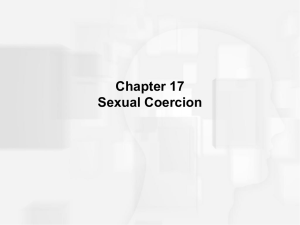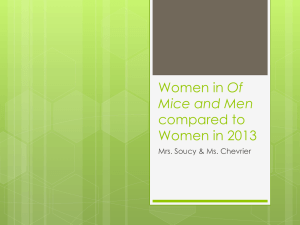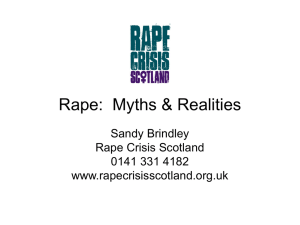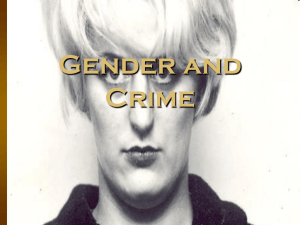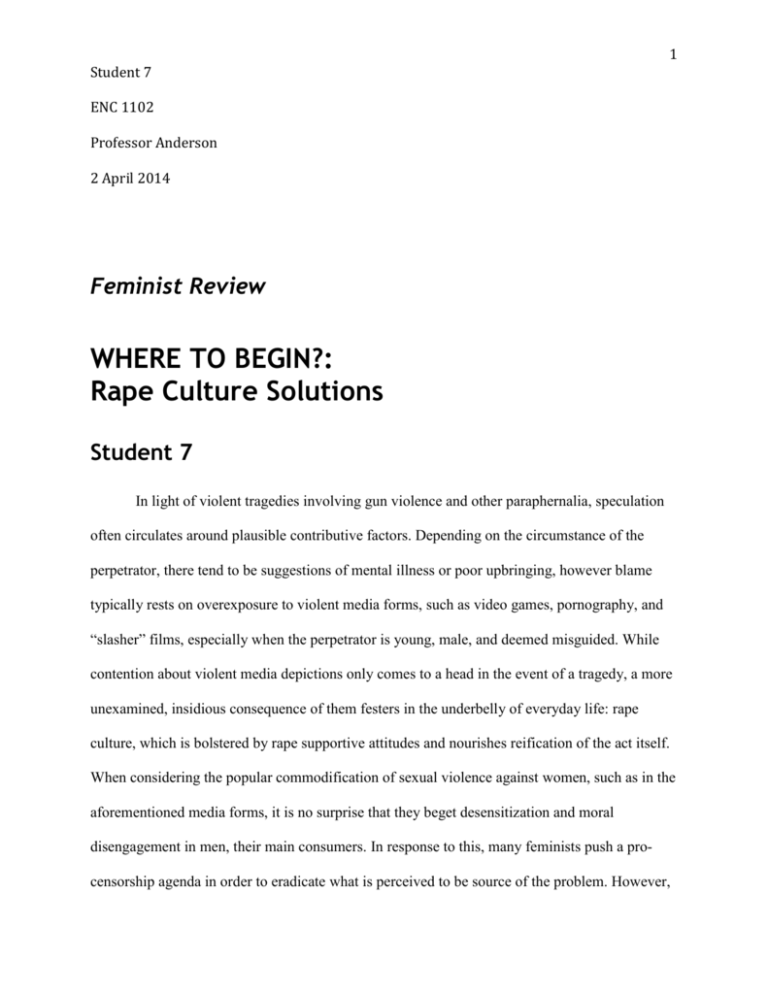
1
Student 7
ENC 1102
Professor Anderson
2 April 2014
Feminist Review
WHERE TO BEGIN?:
Rape Culture Solutions
Student 7
In light of violent tragedies involving gun violence and other paraphernalia, speculation
often circulates around plausible contributive factors. Depending on the circumstance of the
perpetrator, there tend to be suggestions of mental illness or poor upbringing, however blame
typically rests on overexposure to violent media forms, such as video games, pornography, and
“slasher” films, especially when the perpetrator is young, male, and deemed misguided. While
contention about violent media depictions only comes to a head in the event of a tragedy, a more
unexamined, insidious consequence of them festers in the underbelly of everyday life: rape
culture, which is bolstered by rape supportive attitudes and nourishes reification of the act itself.
When considering the popular commodification of sexual violence against women, such as in the
aforementioned media forms, it is no surprise that they beget desensitization and moral
disengagement in men, their main consumers. In response to this, many feminists push a procensorship agenda in order to eradicate what is perceived to be source of the problem. However,
Kahn 2
this proves to be infeasible due to its violation of first amendment rights, and has been struck
down countless times for this very reason, such as in the case of the Indianapolis AntiPornography Ordinance. Furthermore, since an institutionalized rape education program has yet
to be established, the same people who are exposed to misogynistic material are compelled to
seek out rape education through unreliable agencies, such as the media, parents, peers, and
teachers, all of which harbor their own preconceived notions about this heinous crime, which in
turn does little to negate rape supportive attitudes, and in fact, can actually perpetuate them.
In opposition to the unrealistic, as well as legislatively impossible suggestion of
censorship, this paper will explore more viable solutions that aim to counteract the harmful
effects of misogynistic media. In the process of doing so, I will use my own research on the
correlation between rape myth acceptance scores and source of rape education in order judge the
efficacy or detriments of certain informative agents. I will then be able to gauge the remedies
needed for combatting rape culture.
The ubiquity of rape
Nobody is immune to rape myth acceptance, especially in a society where misogynic acts are
bottled up and sold under the guise of shock factor and victims are blamed for provoking their
attacker. Violent video games such as Grand Theft Auto IV, which caters to a demographic of
young, impressionable men, provide a medium through which these men are encouraged to
channel their curiosities and fantasies. It is no surprise that, as proved in scientific studies, a
game such as this, which allows players to have sex with prostitutes and kill them, would
indiscriminately foster “prejudicial, stereotyped, or false beliefs about rape, rape victims, and
rapists” (Beck 3018) vis-à-vis the player’s already shallow and misinformed comprehension of
Kahn 3
the crime. The same rings true for pornography, which has been proven to increase consumers’
risk of aggression against women, regardless of genre. “Slasher” films on the other hand,
undertake a more implicit contribution to rape culture, often by sexually jeopardizing women and
using their peril as a tool for shock value in order to seduce profit from a bored, desensitized
audience who is looking for their next stimulatory fix. These are only three of the countless
examples of the celebration and commercialization of rape in Western culture, so it is no wonder
why consumers of it, passive or not, have become so calloused toward the act, and even worse,
infatuated with it. And if these misogynistic vehicles are so ubiquitous in our media-immersed
society, why has rape been regarded as too trivial or too exceptional to be educated on? This
disdain is what produces negligence, both towards the crime as well as the victims. Rape culture
is an opportunist that breeds under the noses of vulnerable, unaware consumers of it, and
education is the only feasible taper.
Education, or eradication?
While many prominent anti-pornography feminists, such as Andrea Dworkin and Catharine
MacKinnon, who drafted the Indianapolis Anti-pornography Ordinance, make a strong case for
censorship, insisting that misogynistic media impedes on women’s civil rights by promoting
sexual discrimination, it proves to be unviable in practice. Take for example the case of
American Booksellers Association, Inc. v. Hudnut, which contested that the anti-pornography
ordinance was too vague and would unintentionally censor “valuable speech”, such as classic
literature pieces like To Kill a Mockingbird, in which a rape case is the cornerstone of the novel
(Dombrow 94). Although legitimate in it’s own respect, this case is just one example of multiple
censorship ordinances that have been struck down on a first amendment basis, further proving
Kahn 4
the concept to be misguided and futile. Rather than beating a dead horse with censorship
rhetoric, the obvious course of action is to realign efforts into rape education and devise a plan
that would homogeneously hamper the development of rape supportive attitudes.
Efficacy of current education
A survey was conducted to test for a correlation between rape myth acceptance scores
and source of education acquired. Participants were given questions derived from the Illinois
Rape Myth Acceptance Scale, which gauges internalized justifications of rape, such as “She
asked for it”, “He didn’t mean to”, “It wasn’t really rape”, and “She lied”. Participants with
higher scores exhibit greater likelihood to condone the crime or perpetrate it themselves.
Participants were also asked about their source of education, and these results were crosstabulated to account for correlations.
Kahn 5
As shown in the results, rape education provided by the media/other generated the highest
mean rape myth acceptance scores, reported at 52.6/110. The majority of respondents claimed
“other” as TV and social media, therefore it is no surprise that they exhibit the highest rape myth
acceptance scores, given the inaccurate depictions of sexualized violence against women in
widely popular TV shows such as Law and Order: Special Victims Unit, which 2 respondents
specified has been their educational source on television. Portrayals of rape cases, such as the
ones seen in SVU, sensationalize the act, which can often have desensitizing affects for viewers,
and are irreconcilable with the reality of the crime. Although the media exercises agenda setting
by highlighting brutal, yet atypical rape cases, such as those committed by strangers in an
alleyway, realistically, 73% of rape cases are committed by non-strangers. Therefore, since these
dramatized depictions fail to resonate with everyday circumstance, this misinforms the viewers,
which leaves women more vulnerable to being victimized, and promotes advantageous
comparison in men, during which they morally disengage with the act by comparing themselves
to the sensationalized perpetrators on television.
Surprisingly, participants who received sex education from their teachers had the second
highest mean rape myth acceptance score of 50.5/110. This is alarming due to teachers’
authoritative relationship with students, which may be granting them the opportunity to
indoctrinate their own biases about sexual assault in their students. Although learning takes place
in a seemingly regulated institution, the lack of homogenized education on the matter permits
rape supportive attitudes to seep into this environment, especially in regard to social studies
classes. Similarly, this is an applicable explanation as to why parents, as a source of education,
have reared the 3rd highest rape myth acceptance scores among respondents. Although Western
society is slowly progressing toward sexual liberation, older generations, and even the current
Kahn 6
one to some extent, still harbors repressive and puritanical attitudes toward sexuality and sexual
autonomy. The bolstering of abstinence rhetoric, although supposedly propagated in the interest
of protecting “purity”, creates a hegemonic structure that praises certain forms of sexual
expression, such as those that are heteronormative and cater to procreation, while condemning
others, such as pleasure driven, non-heterosexual acts. This cult of purity not only attaches
stigma to certain sexualities, but it also attaches value to certain women, therefore the abstinence
approach distracts from rape awareness, and can often nourish rape supportive attitudes and
victim blaming. Thus, parents, who attempt to stunt early sexual gratification by sheltering their
children, are not reliable disseminators of rape education, as proved by the survey results.
Respondents who had received their education from peers as well as sex education
programs exhibited the lower rape myth acceptance. Although a 1.2 point disparity is not
significant, the reliability and efficacy of each source must be considered respectively, and as
part of a larger enterprise. While both yield similar results in a small sample, cohesive sex
education is a much more reliable and consistent tactic, as opposed to peer education, which is
erratic and rooted in subjectivity. Rape is usually not the explicit, hyper-violent act that the
media represents it as; therefore, it cannot be educated about in passing. Defusing rape culture
requires proper awareness through institutionalized programs that are inclusive in their
preventative tactics, rather than exclusively gendered.
So, where to begin?
Many may have qualms about the appropriateness of such dialogue in an institutionalized
setting, such as a classroom. On the contrary, however, classrooms, more specifically social
studies classes, are an ideal setting for rape education to take place. Since social studies teachers
Kahn 7
have a “defining interest in citizenship education” (Crocco 66), they are in a reliable position to
conduct discourses about gender, sexuality, and misogyny. However, this proves to be no easy
feat, given the aforementioned evidence that teachers harbor their own biases and can have a
negative influence on rape myth acceptance. Therefore, before any such dialogue is assimilated
into the curriculum, “teachers must grapple with their own attitudes about these issues” (Crocco
69). Another obstacle facing this tactic is the possible struggle that students may face when
attempting to comprehend such dense material. With regard to this, teachers must utilize a
“social change approach”, which dictates that they approach the subject matter in a manner that
“encourages students to understand themes, events, concepts, and issues from different
perspectives” (Crocco 69) while requiring them to exercise problem solving skills when they are
confronted with an issue, such as sexual assault.
In addition to being institutionalized, rape education must be tailored to resonate with
men. Since an overwhelming ¼ of women are victims of rape, the crime is typically discussed in
gender exclusive terms, in which women are automatically designated as victims, and men are
presumed assailants. This is reflected in current education tactics, such as the “risk-reduction”
(Edwards 22) strategy, which holds women responsible for taking preventative measures to
avoid being assaulted, and thus, consequently, implicates men as innately and inevitably violent.
In order to effectively incite men to be active participants in prevention, education tactics must
instead address rape as a crime that is committed across a “spectrum of gender” (Edwards 2009).
Furthermore, a “Men as Allies” based intervention, which empowers men to intervene when
assault occurs, coupled with “social norms theory”, which employs anti-misogynist social norm
as incentive to reject rape culture, have been proven to effectively engage men in prevention
tactics, and therefore must also be implemented as educational strategies (Hillenbrand-Gunn 43).
Kahn 8
Finally, since rape is often politicized and appropriated as feminist issue, this “alienates many
young males” (McEvoy), which further reinforces a dissociation from the act, and alleviates
preventative responsibility.
Conclusion
As exhibited by evident correlation in the survey results, we can no longer rely on
inconsistent educational sources, especially when they beget the endangerment of safety in ¼
women. When attempting the curtail the growing rates of sexual assault, which are a
manifestation of a culture that harbors rape supportive attitudes and victim blaming, we must
first begin by acknowledging rape as an epidemic that is worthy of institutionalized awareness
education. We must oppose sexual repression and unviable censorship in favor of honest,
legitimate education, as well as include men as equally autonomous participants in the battle
against sexual assault. In doing this, our culture may finally begin to shed its heavily instilled
misogynistic attitudes in favor of an equitable, safe environment.
Kahn 9
Works Cited
Beck, Victoria Simpson1, et al. "Violence Against Women In Video Games: A Prequel Or
Sequel To Rape Myth Acceptance?" Journal Of Interpersonal Violence 27.15 (2012):
3016-3031. OmniFile Full Text Mega (H.W. Wilson). Web. 4 Feb. 2014.
Crocco, M. (2001). The missing discourse about gender and sexuality in the social studies.
Theory Into Practice, 40(1), 65-71.
Dombrow, Derian. "Constitutional Law: Death of an Ordinance: Pornography Unconstitutionally
Defined as Sex Discrimination." Loyola of Los Angeles Entertainment Law Review
(1987): 88-96. Web.
Edwards, K. E. (2009). Effectiveness of a Social Change Approach to Sexual Assault Prevention.
(Undetermined). College Student Affairs Journal, 28(1), 22-37.
Hillenbrand-Gunn, T. L., Heppner, M. J., Mauch, P. A., & Park, H. (2010). Men as Allies: The
Efficacy of a High School Rape Prevention Intervention. Journal Of Counseling &
Development, 88(1), 43-51.
McEvoy, A. W. (1992). Talking about date rape to male students. Education Digest, 5742-43.
"The Rapist Isn't a Masked Stranger." N.p., n.d. Web.




